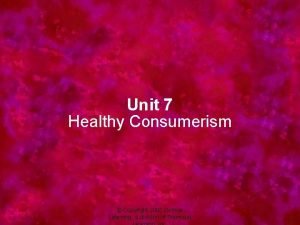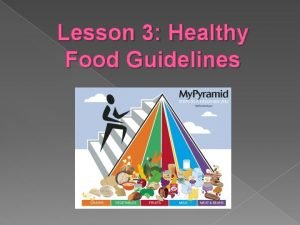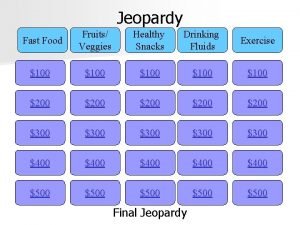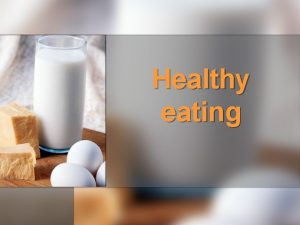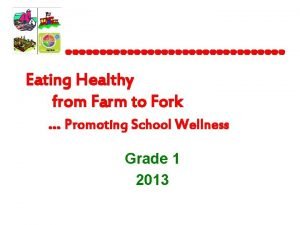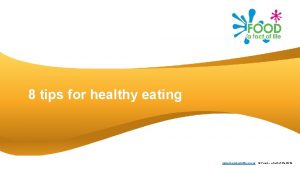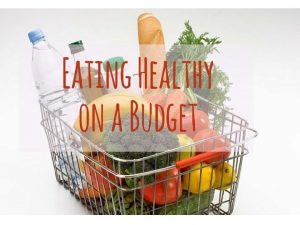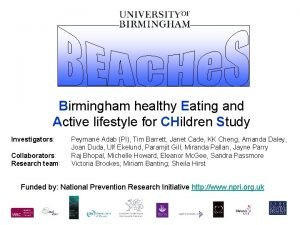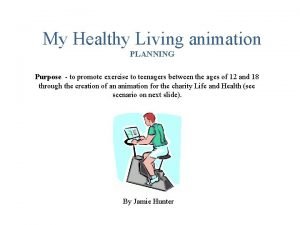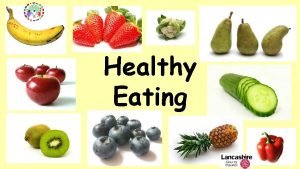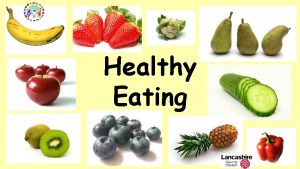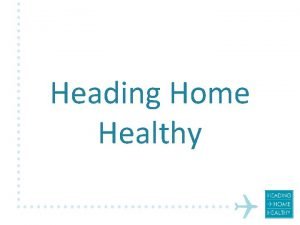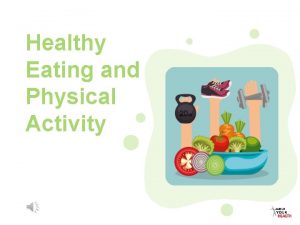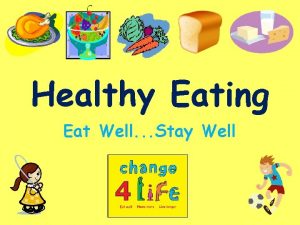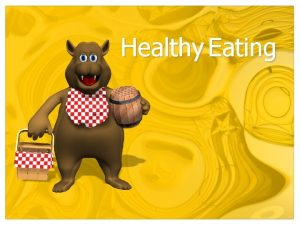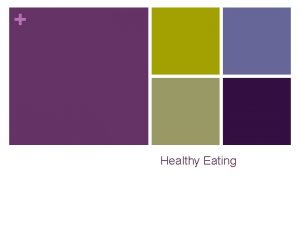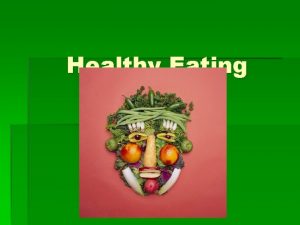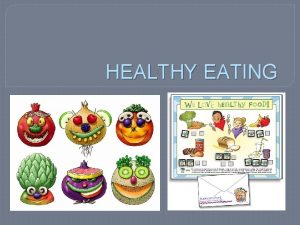4 EATING WELL Eating healthy and wise Home













- Slides: 13

4 EATING WELL Eating healthy and wise Home Gardening and Nutrition Training Material

1. A balanced and diverse diet Having a balanced and diverse diet: – keeps our bodies and minds healthy, – gives the body energy to function well and be active, – helps the body to fight infections and illness, – helps children to develop to their full potential, – contributes to safer pregnancy and child birth.

1. A balanced and diverse diet • A healthy diet includes a variety of foods from different groups. • Too much as well as too little food is bad for our body. A healthy balanced diet has the right proportions of good quality foods, as shown in the figure:

1. A balanced and diverse diet Staples: Should be the biggest portion on the plate and the main component of your diet. They provide energy and help our body grow and repair. Vegetables and fruits: Should represent around 1/3 of the plate. Have plenty of them – as snacks between meals for example. They protect our body against illness.

1. A balanced and diverse diet Animal foods and legumes: Should be a smaller portion of the plate. They enable our body to grow and repair. Every day, one should have at least ONE of them. Fats and oils: Should form a small part of the plate (e. g. 3 -4 tbs per day person). They provide energy and improve protective function of vegetables.

1. A balanced and diverse diet Why drinking safe water? – Water is needed for digestion and absorption. – Dirty water can carry diseases (e. g. diarrhoea), malnutrition and mortality. Each person needs to drink 8 glasses of safe water a day.

2. Food preservation • Why preserving food? – To have food products available when they are out of season or in short supply – To help ensuring a diversity of nutrients • How to preserve food? – Bottling, drying, or freezing

3. Special needs 3. a. Mother and child feeding Healthy eating for women is crucial especially: - During pregnancy - When breastfeeding - When feeding a young child Proper feeding enables: - The mother to feel well and active. - Making birth easier. - Proper growth and development of the child. - Helping the mother to breastfeed the baby successfully.

3. a. Mother and child feeding Pregnant women: - Eat extra nutritious snacks during the day. Take iron and folic acid tablets prescribed at the health centre. - Attend ante-natal clinics as instructed by the health personnel. Breastfeeding mothers: - Eat a little more at each meal/have smaller frequent meals. - Eat nutritious snacks between meals. - Take vitamin A capsules. - Attend post-natal clinics.

3. a. Mother and child feeding Feeding babies aged 0– 6 months: - Exclusive breastfeeding for babies under 6 months of age. - Attend health centre monthly for growth monitoring. Feeding Children over 6 months: - Breastfeeding until 2 years old highly recommended. - From 6 months old, give complementary foods in addition to breastfeeding.

3. a. Mother and child feeding Feeding the babies of HIV-infected mothers • HIV-infected mothers on ART should: - adhere to medication - breastfeed exclusively their babies under 6 months - introduce complementary foods when the child is 6 months - continue to breastfeed until the child is 12 months. • After 12 months of age, breastfeeding should stop ONLY once a nutritionally adequate and safe diet without the breast milk can be provided to the infant.

3. b. Preventing malnutrition Children are at risk of malnutrition when they: – Are not eating the right foods in quantity, quality and diversity. – Suffer from diseases (e. g. diarrhoea) or infections (e. g. hookworms, HIV/AIDS). The risk of malnutrition is high for children, especially from 6 months to 2 years old, when breast milk is no longer enough for the growth and development of babies. This is a critical time for growth monitoring. Malnutrition can be prevented with: a diverse, balanced diet and good hygiene practices.

3. c. The elderly Elderly people need to eat well to stay healthy. Prioritize: - Dairy - Fruits and vegetables - Water ! Elderly may lose appetite and have more difficulty to chew. Bear this in mind when preparing the meals. 3. d. Obesity Overweight can be caused by eating too much of staple foods, fats or sugar. Consequences can be: - Diabetes - Less energy - Heart diseases - Less endurance - High blood pressure
 He who walks with the wise grows wise
He who walks with the wise grows wise Unit 7 healthy and wise
Unit 7 healthy and wise Interactive guide to healthy eating and active living
Interactive guide to healthy eating and active living Healthy food healthy mind journal
Healthy food healthy mind journal Healthy soil healthy life poster ideas
Healthy soil healthy life poster ideas Healthy forests healthy communities poster contest
Healthy forests healthy communities poster contest Healthy nurse healthy nation
Healthy nurse healthy nation Fast food jeopardy questions
Fast food jeopardy questions 5 sentences on health
5 sentences on health Eating healthy from farm to fork
Eating healthy from farm to fork Foodafactoflife
Foodafactoflife What s for dinner tonight
What s for dinner tonight Healthy eating birmingham
Healthy eating birmingham Healthy eating animation
Healthy eating animation

